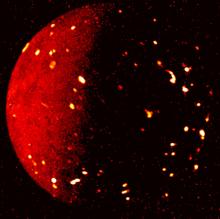Listen to today's episode of StarDate on the web the same day it airs in high-quality streaming audio without any extra ads or announcements. Choose a $8 one-month pass, or listen every day for a year for just $30.
You are here
Moon and Jupiter
The Moon and Jupiter form a beautiful pairing late tonight. Jupiter looks like a brilliant star. It’s quite close below the Moon as they climb into good view, after midnight.
Jupiter is the largest and heaviest planet in the solar system — 11 times wider and more than 300 times as massive as Earth. In fact, its core alone is more than 10 times Earth’s mass. But it’s not in the form that scientists had expected.
Until a few years ago, most ideas of how Jupiter is put together said it had a solid core made of rock and metal. But the Juno spacecraft has found otherwise. It’s measured Jupiter’s magnetic and gravitational fields from orbit. Those observations have given scientists a much better picture of how Jupiter is put together.
They show that the core is “diffuse,” like a scoop of ice cream left on the kitchen counter for a few minutes. The core melts into the surrounding layers of material.
One possible explanation is that a planet about 10 times the mass of Earth slammed into Jupiter when it was quite young. It would have smashed the core like a bowling ball hitting a set of pins, sending them flying in all directions. The core then stayed scattered and mushy.
But a recent study suggests the core would have pulled itself back together within hours of the impact, no matter what the speed or angle of the collision. So scientists may still have some work left to explain Jupiter’s “melty” center.
Script by Damond Benningfield





